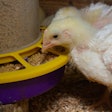
In Asia, only Taiwan has reported new outbreaks of highly pathogenic avian influenza (HPAI) in poultry, while there have been further cases in wild animals in China, South Korea, and Russia’s Far East.
In other developments in Asia, a new Chinese study shows that one avian flu virus is becoming a growing threat to human and bird health. There have been two further human infections in China.
Over the past few weeks in Asia, only Taiwan has officially registered new HPAI outbreaks in commercial poultry.
Starting between mid-July and the end of August, six outbreaks were reported to the World Organisation for Animal Health (WOAH) by the Taiwanese veterinary authority.
One recent case in a small group of native chickens was picked up at a Taipei slaughterhouse, while the others were confirmed on farms. Affected were three flocks of native chickens — each with between around 14,000 and 37,000 birds. Also testing positive for the H5N1 virus serotype were 3,130 meat ducks and 79,300 quails. The outbreaks occurred in the counties of Pingtung, Chiayi, Changhua, and Yunlin.
Since November of last year, Taiwan has recorded 59 outbreaks linked to this virus variant. Directly impacted have been almost 1.17 million poultry.
According to the agency, the virus detected at each location is of Eurasian lineage, and belongs to the clade 2.3.4.4b.
At the start of 2023, one HPAI outbreak linked to the H5N5 was detected in a Taiwan poultry flock, according to a WOAH notification at the time. Since then, no further cases have been detected, and the animal health agency has declared to the Organisation that the outbreak series has been “resolved.”
HPAI reported to be under control in Nepal, Philippines
Also recently declaring to WOAH that the HPAI situation in poultry has ended in their respective countries have been Nepal and the Philippines.
Between January and June of this year, presence of the H5N1 HPAI virus variant was confirmed at 18 locations in Nepal. Although the poultry involved are described as backyard chickens and ducks of different ages, all outbreaks were at premises described in the official reports as “farms.” Each had between 342 and 11,100 birds. While most involved laying hens, some flocks included turkeys, meat chickens, and broiler breeders.
All the affected units were located in the central province of Bagmati, near to the capital city, Kathmandu.
As previously reported by local media, the Philippines’ animal health agency declared to WOAH early in August that the HPAI situation was resolved in the province of Capiz.
In November of last year, this province in the Western Visayas region recorded its first ever HPAI outbreak linked to the same virus variant. Since the cases were detected at a small poultry farm, no further outbreaks have been reported.
Up to June of this year, the same virus serotype was detected at locations on the country’s main islands of Luzon and Mindanao, based on previous WOAH notifications.
Philippines prepares for HPAI vaccination
Earlier this month, the Philippines News Agency (PNA) reported that the country’s poultry sector can expect a boost in the form of avian flu vaccines.
This news followed fruitful discussions between President Ferdinand R. Marcos and Indonesian veterinary drug company, PT Vaksindo Sadwa Nustantara. Working through its local partner, Univet Nutrition and Animal Healthcare Company, Vaksindo has apparently undertaken to invest US$2 million in vaccines this year, including one for the Philippines against HPAI.
Since 2017, more than 10 million laying hens have been culled in the Philippines due to HPAI. As a result, domestic egg production was down 20% in April. This has led to high egg prices on the market, and made this staple food unaffordable for some citizens. Rising prices of chicken meat are also being blamed on the threat of new outbreaks, according to PNA.
Announcing the agreement at the event Livestock and Aquaculture in the Philippines, President Marcos stated he will address the challenges experienced by these two vital sectors of the national economy.
HPAI situation in Asia’s wild birds
In April of this year, South Korea officially declared to WOAH that the HPAI situation was “resolved” in both poultry and wild birds.
However, in the first week of this month, the agriculture ministry reported that wild bird droppings collected as part of national surveillance had tested positive for an H5 antigen. Tests to identify the virus involved are ongoing. The sample had been collected in the Paju city area.
Located in the northwestern province of Gyeonggi that surrounds the capital, Seoul, Paju shares a border with North Korea.
In recent weeks, presence of the H5N1 HPAI virus was detected in wild birds in two regions of Russia’s Far Eastern federal district.
At three locations in the oblast of Sakhalin, this virus was linked to the mass mortality of more than 240 aquatic birds of the auk family since February.
Furthermore, as a result of surveillance, one wild duck found dead in Primorskiy krai in mid-August has tested positive for the same virus serotype, according to the latest WOAH notification.
Meanwhile, China’s animal health agency has reported that a mass mortality of wildlife in the Tibet Autonomous Region in July was also linked to the H5N1 virus variant.
At a natural park near Nagchu city, around 5,200 birds of unspecified type died, according to the official report. Source of infection was identified as contact with wild species.
Further H5N1 cases in non-avian species
In July of this year, the H5N1 HPAI virus was reported to be involved in the first deaths among cats in the South Korea.
Since the first two cases, a further seven cats have died in Seoul, according to an updated WOAH notification. Affected have been feral cats at two animal shelters.
Last month, Yonhap news agency of South Korea reported the cat food from one of these premises had tested positive for an HPAI virus of the H5 family. The manufacturer was ordered to recall and destroy all affected products after it was found that the food had not been properly processed to destroy potential pathogens due to an equipment breakdown.
Investigations are now underway at other sites in South Korea where poultry and other meats are included in pet foods.
Meanwhile, in Russia’s Far Eastern federal district, the first wild mammal has tested positive for the H5N1 virus.
According to the official notification to WOAH, the infection was in a Northern fur seal found dead in Sakhalin oblast in mid-August. As no further cases have been detected, the Russian authorities have subsequently declared this disease outbreak series closed.
Two further human infections in China
In the Western Pacific region, one new case of influenza A virus of avian origin in China has been confirmed to the World Health Organization (WHO).
Linked to the avian influenza A(H5N6) virus was an infection in a 27-year-old woman in Chongqing province at the end of August. The report does not mention either the current condition of the patient, or the most likely source of infection.
So far this year, this is the first cases in the province, and the fifth in China related to this virus variant. This case brings to 87 the number of lab-confirmed infections with this virus in the Western Pacific region reported to WHO since 2014. All but one of these cases were in mainland China, and 33 of the patients have died.
In early August, a four-year-old Chinese child tested positive for an influenza A virus of the H9 family, according to the Centre for Health Protection in Hong Kong.
The girl was from Sichuan province, and she in the fourth case linked to this virus family reported in China over the past six months. No details are given about her condition or whether poultry could be the source of infection.
Study warns of growing epidemic potential
Research carried out on a related flu virus in China indicates its recent mutations make it more of a threat to human health.
The study was a collaboration between the China Agricultural University in Beijing, the Chinese Academy of Sciences, the Chinese Center for Disease Control and Prevention, and the University of Nottingham in the United Kingdom.
Published in the journal Cell, the paper reports that the H3N8 influenza virus has adapted to cause more severe infections in animals, as well as making it more easily transmissible in air. The research was carried out in animal models, using viruses from a human patient.
This virus type is known to be widespread in chicken flocks.
The study’s findings raise concerns about a possible future epidemic or pandemic relating to this virus, according to the scientists. They also stress the need to monitor closely changes in such viruses — in both humans and poultry.
View our continuing coverage of the global avian influenza situation.
















